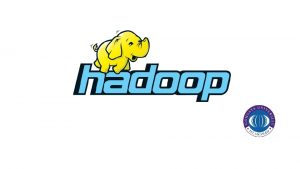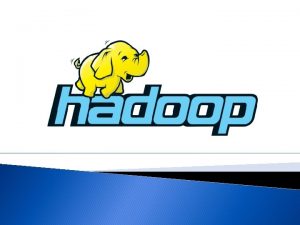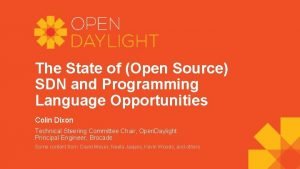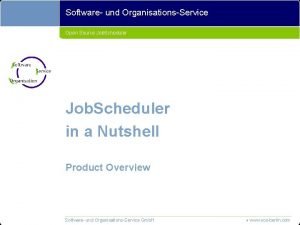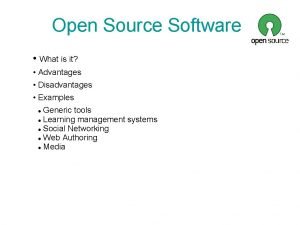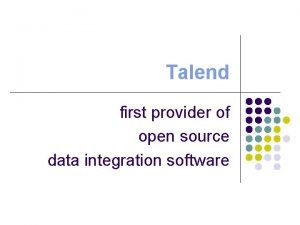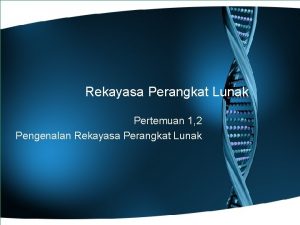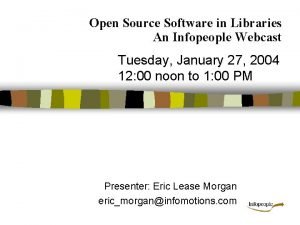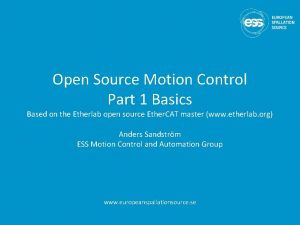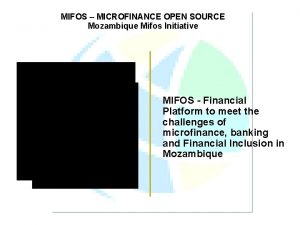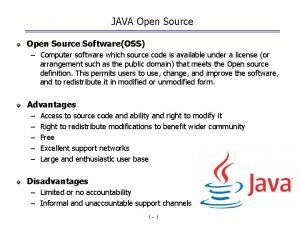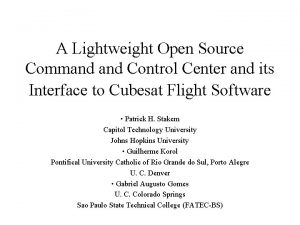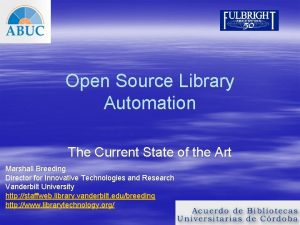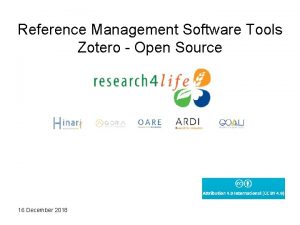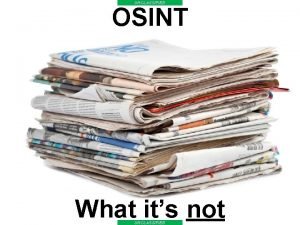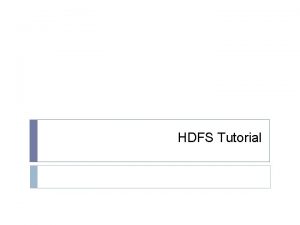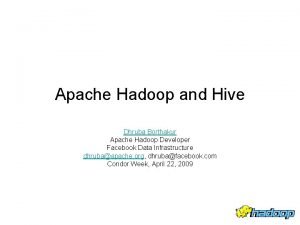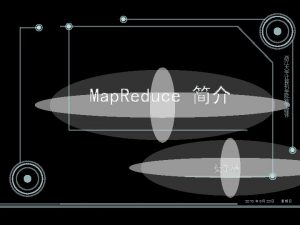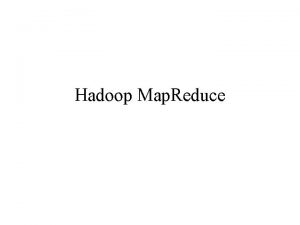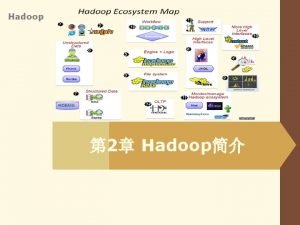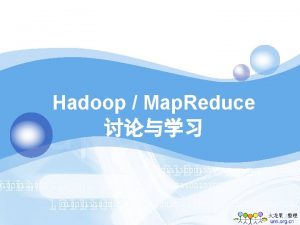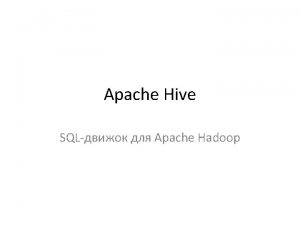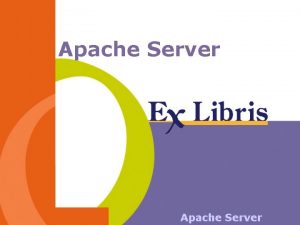What is Apache Hadoop Open source software framework


















































- Slides: 50


What is Apache Hadoop? • Open source software framework designed for storage and processing of large scale data on clusters of commodity hardware • Created by Doug Cutting and Mike Carafella in 2005. • Cutting named the program after his son’s toy elephant.

Uses for Hadoop • Data-intensive text processing • Graph mining • Machine learning and data mining • Large scale social network analysis

Who Uses Hadoop?

The Hadoop Eco. System 5

The Hadoop Ecosystem Ambari • Management & Monitoring tool HDFS • Hadoop Distributed File System Hadoop YARN • Yet Another Resource Negotiator Hadoop Map. Reduce • A programming model for large scale data processing

What considerations led to its design Motivations for Hadoop

Motivations for Hadoop • What were the limitations of earlier large-scale computing? • What requirements should an alternative approach have? • How does Hadoop address those requirements?

Why should we use Hadoop? • Need to process 10 TB datasets • On 1 node: – scanning @ 50 MB/s = 2. 3 days • On 1000 node cluster: – scanning @ 50 MB/s = 3. 3 min • Need Efficient, Reliable and Usable framework – Google File System (GFS) paper – Google's Map. Reduce paper

Early Large Scale Computing • Historically computation was processor-bound – Data volume has been relatively small – Complicated computations are performed on that data • Advances in computer technology has historically centered around improving the power of a single machine

Cray-1

Advances in CPUs • Moore’s Law – The number of transistors on a dense integrated circuit doubles every two years • Single-core computing can’t scale with current computing needs

Single-Core Limitation • Power consumption limits the speed increase we get from transistor density

Distributed Systems • Allows developers to use multiple machines for a single task

Distributed System: Problems • Programming on a distributed system is much more complex – Synchronizing data exchanges – Managing a finite bandwidth – Controlling computation timing is complicated

Distributed System: Problems “You know you have a distributed system when the crash of a computer you’ve never heard of stops you from getting any work done. ” – Leslie Lamport • Distributed systems must be designed with the expectation of failure

Distributed System: Data Storage • Typically divided into Data Nodes and Compute Nodes • At compute time, data is copied to the Compute Nodes • Fine for relatively small amounts of data • Modern systems deal with far more data than was gathering in the past

Requirements for Hadoop • Must support partial failure • Must be scalable

Partial Failures • Failure of a single component must not cause the failure of the entire system only a degradation of the application performance � Failure should not result in the loss of any data

Component Recovery • If a component fails, it should be able to recover without restarting the entire system • Component failure or recovery during a job must not affect the final output

Scalability • Increasing resources should increase load capacity • Increasing the load on the system should result in a graceful decline in performance for all jobs – Not system failure

Hadoop • Based on work done by Google in the early 2000 s – “The Google File System” in 2003 – “Map. Reduce: Simplified Data Processing on Large Clusters” in 2004 • The core idea was to distribute the data as it is initially stored – Each node can then perform computation on the data it stores without moving the data for the initial processing

Core Hadoop Concepts • Applications are written in a high-level programming language – No network programming or temporal dependency • Nodes should communicate as little as possible – A “shared nothing” architecture • Data is spread among the machines in advance – Perform computation where the data is already stored as often as possible

High-Level Overview • When data is loaded onto the system it is divided into blocks – Typically 64 MB or 128 MB • Tasks are divided into two phases – Map tasks which are done on small portions of data where the data is stored – Reduce tasks which combine data to produce the final output • A master program allocates work to individual nodes

Fault Tolerance • Failures are detected by the master program which reassigns the work to a different node • Restarting a task does not affect the nodes working on other portions of the data • If a failed node restarts, it is added back to the system and assigned new tasks • The master can redundantly execute the same task to avoid slow running nodes

HADOOP DISTRIBUTED FILE SYSTEM HDFS

Overview • HDFS is the primary storage system of Hadoop • Responsible for storing data on the cluster • Data files are split into blocks and distributed across the nodes in the cluster • Each block is replicated multiple times

HDFS Basic Concepts • HDFS is a file system written in Java based on the Google’s GFS • Provides redundant storage for massive amounts of data

HDFS Components: • Name. Node • Data. Nodes 29

Tasks of Name. Node • Manage file system namespace. • Regulates client’s access to files. • Executes file system execution such as naming, closing, opening files and directories. 30

Tasks of Data. Node • Data. Node performs operations like block replica creation, deletion, and replication according to the instruction of Name. Node. • Data. Node manages data storage of the system. 31

HDFS - Hadoop Distributed FS • Hadoop uses HDFS, a distributed file system based on GFS, as its shared file system – Files are divided into large blocks and distributed across the cluster (64 MB) – Blocks replicated to handle hardware failure – Current block replication is 3 (configurable) – It cannot be directly mounted by an existing operating system.

How are Files Stored • Files are split into blocks • Blocks are split across many machines at load time – Different blocks from the same file will be stored on different machines • Blocks are replicated across multiple machines • The Name. Node keeps track of which blocks make up a file and where they are stored

Data Replication • Default replication is 3 -fold

Data Retrieval • When a client wants to retrieve data – Communicates with the Name. Node to determine which blocks make up a file and on which data nodes those blocks are stored – Then communicated directly with the data nodes to read the data

Distributing computation across nodes Map. Reduce

Map. Reduce Overview • A method for distributing computation across multiple nodes • Each node processes the data that is stored at that node • Consists of two main phases – Map – Reduce

Map. Reduce Features • Simplicity – Map. Reduce jobs are easy to run. Applications can be written in any language such as java, C++, and python. • Scalability – Map. Reduce can process petabytes of data. • Speed – By means of parallel processing problems that take days to solve, it is solved in hours and minutes by Map. Reduce. • Fault Tolerance – Map. Reduce takes care of failures. If one copy of data is unavailable, another machine has a copy of the same key pair which can be used for solving the same subtask.

The Mapper • Reads data as key/value pairs – The key is often discarded • Outputs zero or more key/value pairs

Shuffle and Sort • Output from the mapper is sorted by key • All values with the same key are guaranteed to go to the same machine

The Reducer • Called once for each unique key • Gets a list of all values associated with a key as input • The reducer outputs zero or more final key/value pairs – Usually just one output per input key

Map. Reduce: Word Count

What parts actually make up a Hadoop cluster ANATOMY OF A CLUSTER

Overview • Name. Node – Holds the metadata for the HDFS • Secondary Name. Node – Performs housekeeping functions for the Name. Node • Data. Node – Stores the actual HDFS data blocks • Job. Tracker – Manages Map. Reduce jobs • Task. Tracker – Monitors individual Map and Reduce tasks

The Name. Node • Stores the HDFS file system information in a fsimage • Updates to the file system (add/remove blocks) do not change the fsimage file – They are instead written to a log file • When starting the Name. Node loads the fsimage file and then applies the changes in the log file

The Secondary Name. Node • NOT a backup for the Name. Node • Periodically reads the log file and applies the changes to the fsimage file bringing it up to date • Allows the Name. Node to restart faster when required

Job. Tracker and Task. Tracker • Job. Tracker – Determines the execution plan for the job – Assigns individual tasks • Task. Tracker – Keeps track of the performance of an individual mapper or reducer

Other available tools HADOOP ECOSYSTEM

Why do these tools exist? • Map. Reduce is very powerful, but can be awkward to master • These tools allow programmers who are familiar with other programming styles to take advantage of the power of Map. Reduce

Other Tools • Hive – Hadoop processing with SQL • Pig – Hadoop processing with scripting • Cascading – Pipe and Filter processing model • HBase – Database model built on top of Hadoop • Flume – Designed for large scale data movement
 Apache hadoop open source
Apache hadoop open source Hadoop open source
Hadoop open source Apache hadoop ecosystem
Apache hadoop ecosystem Hadoop io
Hadoop io Open source erp framework
Open source erp framework 영국 beis
영국 beis Apache web framework
Apache web framework Open source sdn software
Open source sdn software Private cloud open source
Private cloud open source Open source job schedulers
Open source job schedulers Advantages and disadvantages of proprietary software
Advantages and disadvantages of proprietary software Open source lims software
Open source lims software Genealogy software open source
Genealogy software open source Module 4 - open source software and licensing
Module 4 - open source software and licensing Ip address management open source
Ip address management open source Open source vendor management
Open source vendor management Open source data integration software
Open source data integration software Open source meeting software
Open source meeting software Webcast software open source
Webcast software open source Open source motion control
Open source motion control Ils software
Ils software Open source microfinance banking software
Open source microfinance banking software Open source mes software
Open source mes software Open source software java
Open source software java Richard stallman
Richard stallman Big data open source projects
Big data open source projects Open source software movement
Open source software movement Open source command and control software
Open source command and control software Software dentisti open source
Software dentisti open source Benefits of free and open source software
Benefits of free and open source software Digital cemetery
Digital cemetery Big data software open source
Big data software open source Future of open source software
Future of open source software Forecasting software open source
Forecasting software open source Open source library automation software
Open source library automation software Data analytic software
Data analytic software Zotero classic view default
Zotero classic view default Open source integrator
Open source integrator Big data open source projects
Big data open source projects Source of conceptual framework
Source of conceptual framework Dispositional framework vs regulatory framework
Dispositional framework vs regulatory framework Theoretical framework example
Theoretical framework example Drawing a conceptual framework
Drawing a conceptual framework Conceptual framework theoretical framework
Conceptual framework theoretical framework Dispositional framework vs regulatory framework
Dispositional framework vs regulatory framework Theoretical framework example
Theoretical framework example Free wrt
Free wrt Open source electronics prototyping platform
Open source electronics prototyping platform Open source pbx
Open source pbx Nato open source intelligence handbook
Nato open source intelligence handbook Intrusion prevention system open source
Intrusion prevention system open source
